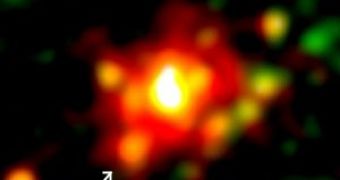Supernovas are explosions of stars that have consumed their hydrogen fuel. Usually the light from a supernova fades after only a few months. However, astronomers have now found that a supernova first discovered in 1979 still emits X-rays today. Scientists are puzzled how can a star fade away in visible light and yet remain so radiant in X-rays.
The reason why a star does not collapse under its own gravity is that the process of fusing hydrogen produces enough energy to counter the pressure from gravitation. However, when the star runs out of hydrogen it starts to implode, but when the core reaches a critical density, much of the collapsing matter gets bounced back out into space by powerful shockwaves. During this process further fusion processes take place and all the existing elements are being created.
A supernova is an outstanding event, so bright that it outshines an entire galaxy. But they are typically half as bright after about ten days and fade steadily after that, regardless of the wavelength.
On the other hand, this supernova, SN 1979C, although it did fade in optical light by a factor of 250 and it became barely visible, is still the brightest object in its host galaxy, M100, in the constellation 'Coma Berenices', in the X-rays domain.
This provided a great opportunity for studying the history of the star. "We can use the X-ray light from SN 1979C as a 'time machine' to study the life of a dead star long before it exploded," said Dr Stefan Immler, leader of the team, from NASA's Goddard Space Flight Center, USA. "This 25-year-old candle in the night has allowed us to study aspects of a star explosion never before seen in such detail. All the important information that usually fades away in a couple of months is still there." If it weren't for the X-ray radiation, the material left over both from the stars activity (the stellar wind) and from the explosion itself would have been invisible. But the X-rays caught up with the solar wind and shined over this material allowing scientists to document the history of the star. In a certain sense this is similar to counting rings in a tree trunk.
The team found that this star was about 18 times more massive than our Sun and produced fierce stellar winds. That material was flung into space for millions of years, creating concentric rings around the star. The X-rays illuminated 16 000 years' worth of stellar activity.
This is truly unique - scientists don't have such information even about our Sun. Also, the scientists could measure the density of the material around the star, another first.
But what causes the persistent X-ray emission? The astronomers speculate that maybe the abundance of stellar wind has something to do with it, as it may have provided ample material to keep SN 1979C glowing so brightly.
The team also used the European Space Agency's XMM-Newton telescope to capture a rare glimpse of the ultraviolet radiation from the supernova. The ultraviolet image has independently confirmed the X-ray analysis: the leftover material covers a region 25 times larger than our Solar System and has a relatively high density - about 1000 times denser than the solar wind from our Sun. The ultraviolet image also shows galaxy M100 in detail never seen before.
"XMM-Newton is known among scientists as a superior X-ray observatory, but the study of SN 1979 demonstrates the importance of the satellite's simultaneously observing ultraviolet and optical telescope," said Dr Norbert Schartel, XMM-Newton Project Scientist at ESA's European Space Astronomy Centre (ESAC) in Spain.
-- The image reveals the X-ray light from the galaxy M100. The most active region is the galaxy centre. The red and orange regions are sources of very hot, diffuse gas between stars. SN 1979C is the orange hotspot about 7 o'clock from the white galactic centre. Credits: ESA/NASA/Immler et al.

 14 DAY TRIAL //
14 DAY TRIAL //